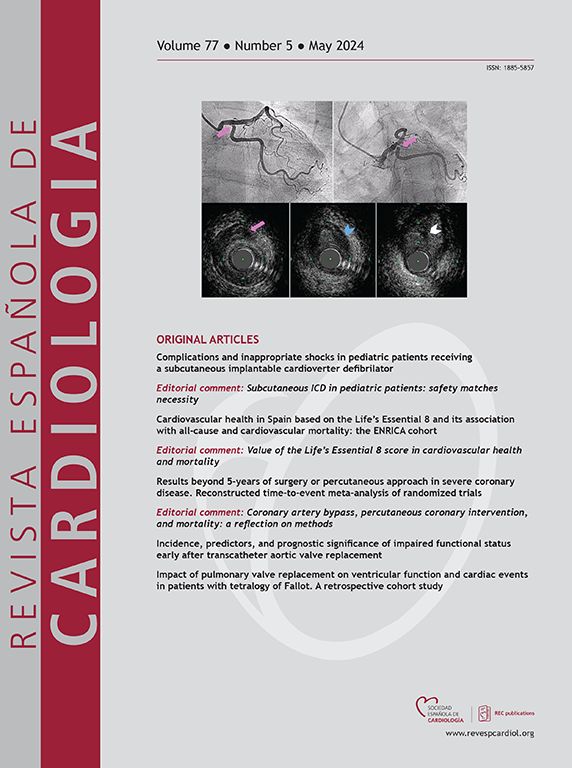从3个西班牙队列的8161名患者中保留射精分数的心力衰竭表型鉴定
IF 5.9
2区 医学
Q2 Medicine
引用次数: 0
摘要
前言和目的确定具有保留射血分数(HFpEF)的心力衰竭的表型,比较死亡率,并研究治疗是否根据表型有不同的效果。方法:我们对8161例HFpEF患者进行了二次分析,这些患者分别来自西班牙心脏病学(INCLIVA)、内科(RICA)和急诊(EAHFE)登记处。基于16个基线特征的表型聚类通过潜在类分析确定。我们分析了粗生存率和治疗调整后的1年生存率,每种治疗与死亡率之间的关系,以及它们与表型的相互作用。结果鉴定出4个不同的聚类。一年死亡率为18.7%。第4类(有瓣膜病表型的年轻女性)的死亡率最低(13.7%,参考类别),在第2类(心脏代谢表型,死亡率:15.7%,校正HR, 1.28, 95%CI, 1.06-1.54)、第3类(非常老年女性表型,死亡率:20.4%,校正HR, 1.63, 95%CI, 1.40-1.90)和第1类(男性心肺表型,死亡率:24.0%,校正HR, 1.81, 95%CI, 1.53-2.13)中死亡率逐渐增加。当单独分析每个注册表时,结果非常相似。肾素-血管紧张素系统抑制剂治疗与所有组的更好生存率相关,β受体阻滞剂在组1中有益,抗凝剂在组4中有益。然而,根据表型,没有一种治疗显示出与预后的差异关联。结论本研究定义了4种具有显著预后差异的HFpEF表型。在分析的治疗方法中,只有肾素-血管紧张素系统抑制剂似乎具有普遍的生存益处,没有一种显示出基于表型的差异效应。本文章由计算机程序翻译,如有差异,请以英文原文为准。
Identificación de fenotipos en la insuficiencia cardiaca con fracción de eyección conservada a partir de 8.161 pacientes de 3 cohortes españolas
Introduction and objectives
To identify phenotypes in heart failure with preserved ejection fraction (HFpEF), compare mortality, and investigate whether treatments have different effects according to phenotype.
Methods
We performed a secondary analysis of 8161 patients with HFpEF included in Spanish cardiology (INCLIVA), internal medicine (RICA), and emergency (EAHFE) registries. Phenotypic clusters based on 16 baseline characteristics were identified using latent class analysis. We analyzed crude and treatment-adjusted 1-year survival, the associations between each treatment and mortality, and their interactions with phenotype.
Results
We identified 4 distinct clusters. One-year mortality was 18.7%. Cluster 4 (younger women with a valvular heart disease phenotype) had the lowest mortality (13.7%; reference category), which increased progressively in cluster 2 (cardiometabolic phenotype; mortality: 15.7%; adjusted HR, 1.28; 95%CI, 1.06-1.54), cluster 3 (very elderly female phenotype; mortality: 20.4%; adjusted HR, 1.63; 95%CI, 1.40-1.90), and cluster 1 (male cardiorespiratory phenotype; mortality: 24.0%; adjusted HR, 1.81; 95%CI, 1.53-2.13). The results were very similar when each registry was analyzed individually. Treatment with renin-angiotensin system inhibitors was associated with better survival in all clusters, beta-blockers were beneficial in cluster 1, and anticoagulants in cluster 4. However, none of the treatments showed a differential association with prognosis according to phenotype.
Conclusions
This study defines 4 HFpEF phenotypes with significantly different prognoses. Among the treatments analyzed, only renin-angiotensin system inhibitors seemed to have a generalized survival benefit, and none demonstrated a differential effect based on phenotype.
求助全文
通过发布文献求助,成功后即可免费获取论文全文。
去求助
来源期刊

Revista espanola de cardiologia
医学-心血管系统
CiteScore
4.20
自引率
13.60%
发文量
257
审稿时长
28 days
期刊介绍:
Revista Española de Cardiología, Revista bilingüe científica internacional, dedicada a las enfermedades cardiovasculares, es la publicación oficial de la Sociedad Española de Cardiología.
 求助内容:
求助内容: 应助结果提醒方式:
应助结果提醒方式:


